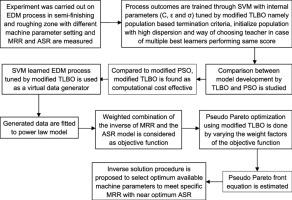Application of teaching learning based optimization procedure for the development of SVM learned EDM process and its pseudo Pareto optimization |
| |
| Affiliation: | 1. Department of Mathematics, Kohat University of Science & Technology, Kohat 26000, Khyber Pukhtunkhwa, Pakistan;2. Department of Mathematical Sciences, University of Essex, Wivenhoe Park, CO4 3SQ Colchester, UK;1. Department of Industrial Engineering, Erciyes University, Kayseri, Turkey;2. Department of Industrial Engineering, Dokuz Eylul University, Izmir, Turkey;1. Polytechnique Montréal Researchers in Software Engineering, École Polytechnique de Montréal, Canada;2. Department of Applied Economics (Mathematics), Universidad de Málaga, Spain;3. Department of Statistics and Operational Research, Universitat de València, Spain;1. School of Economics and Management, Beijing University of Aeronautics and Astronautics, Beijing 100191, PR China;2. School of Accounting and Finance, The Hong Kong Polytechnic University, Hung Hom, Kowloon, Hong Kong;3. School of Business Administration, China University of Petroleum, Beijing 102249, PR China |
| |
| Abstract: | 
Manufacturing processes could be well characterized by both the quantitative and the qualitative measurements of their performances. In case of conflicting type performance measures, it is necessary to get possible optimum values of all performances simultaneously, like higher material removal rate (MRR) with lower average surface roughness (ASR) in electric discharge machining (EDM) process. EDM itself is a stochastic process and predictions of responses – MRR and ASR are still difficult. Advanced structural risk minimization based learning system – support vector machine (SVM) is, therefore, applied to capture the random variations in EDM responses in a robust way. Internal parameters of SVM – C, ɛ and σ are tuned by modified teaching learning based optimization (TLBO) procedure. Subsequently, using the developed SVM model as a virtual data generator of EDM process, responses are generated at the different points in the experimental space and power law models are fitted to the estimated data. Varying the weight factors, different weighted combinations of the inverse of MRR and the ASR are minimized by modified TLBO. Pseudo Pareto front passing through the optimum results, thus obtained, gives a guideline for selection of optimum achievable value of ASR for a specific demand of MRR. Further, inverse solution procedure is elaborated to find the near-optimum setting of process parameters in EDM machine to obtain the specific need based MRR-ASR combination. |
| |
| Keywords: | Teaching learning based optimization (TLBO) Electrical discharge machining (EDM) Support vector machine (SVM) |
| 本文献已被 ScienceDirect 等数据库收录! |
|

